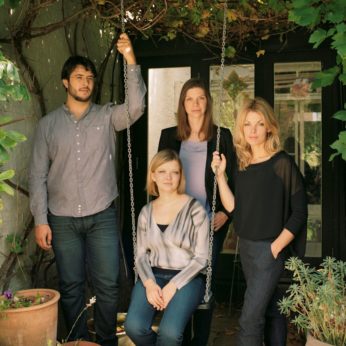Composer: Joseph Haydn (b. 1732 - d. 1809)
Performance date: 05/07/2016
Venue: St. Brendan’s Church
Composition Year: 1772
Duration: 00:23:19
Recording Engineer: Richard McCullough, RTÉ lyric fm
Instrumentation: 2vn, va, vc
Instrumentation Category:String Quartet
Artists:
Chiaroscuro Quartet (Alina Ibragimova, Pablo Hernán Benedí [violins], Emilie Hörnlund [viola], Claire Thirion [cello]) -
[quartet]

In the years 1768-72 Haydn wrote three sets of
string quartets and the third set, the six quartets of Op.20, have become the
foundations of the serious string quartet. Emulated by Mozart, copied out by
Beethoven, revered by Brahms, these quartets have not lacked for high powered
admirers.
It is in this set that the idea of the quartet as a
conversation among equals begins to take hold. Although the first violin still
has the lead part, every part now becomes important. There is no (or very
little) mere accompaniment. The musical structures are often similar to
the ones Haydn usually used; particularly the sonata form. But here these forms
are continually varied. Keys change either before or after they are expected to
change. Instead of using phrases made up of four or six bars, Haydn experiments
with five and seven bar phrases. In
addition three of the last movements of the six quartets are fugues. These stylistic innovations would be of little
interest if they did not also accompany a radical change in emotional power. No-one
knows why Haydn’s personal emotions burst into this music in a way that is
quite unlike his earlier quartets.
When you first hear the Opus 20 quartets do not
expect elegance and charm. For those
qualities, there are plenty of earlier – and later – works. These quartets
often sound awkward. They stop and start at odd moments. There are sudden
crescendos followed by equally sudden quiet moments. Strange unconnected
phrases intrude. Most movements end in quiet, almost inconclusive passages. As if to signal the seriousness of the
quartets Haydn included two (instead of the usual one) in a minor key. Opus 20
no 5 in F minor (which was performed at last year’s festival) is a dark almost
depressing work. No 3 in G minor is not quite so dark but nevertheless is often
disturbed and uneasy.
The first movement’s main theme is made up of two
seven bar phrases. This lopsided motif dominates the movement. After repeating
it, Haydn introduces a small idea based on semiquavers, which recurs throughout.
The second subject consists of a number of stops and starts with surprising
modulations. The development is largely based on the main theme. There is a
false return to the recapitulation. When the recapitulation does happen it is
followed by more development. The movement ends with a series of quiet
modulations, followed by an upward scale played forte by the first violin
before two quiet final chords.
The main theme of the minuet is made up of two five
bar phrases. This mordant minor key dance continues the disturbed mood of the
opening movement. In the good humoured trio, the first violin accompanies the
rest of the quartet with delicate arpeggios. The beautiful calm Adagio begins
with a hymn like tune. In the second subject the cello accompanies the other
instruments with a semi-quaver base line but as the movement continues Haydn exchanges
the roles of the first violin and cello with the violin taking the semi-quaver
passages.
The Finale shows that Haydn can still be humorous
even in a minor key. The movement is in sonata form but with only one theme
which consists of a sufficient number of contrasting phrases to supply Haydn
will all he needs for a wonderful display of contrapuntal quartet writing. All
the instruments share the material. The quartet ends with the cello
accompanying the other three instruments, but as the music fades into silence the
cello has the last word to conclude this strange and remarkable work.
Copyright © 2025 West Cork Music. All rights reserved.
Designed and developed by Matrix Internet